Music Manuscripts & Printed Music
The Morgan houses one of the world’s finest collections of music manuscripts and rare printed scores. In addition to numerous musicians’ letters and first editions of scores and librettos, the holdings include one of the the largest collections of Mahler manuscripts anywhere and substantial holdings of Mozart, Schubert, Chopin, Brahms, Debussy, Richard Strauss, Stravinsky, Ravel, and Schoenberg. Forty thousand collection items span six centuries and many countries. The Morgan’s materials relating to the lives and works of the dramatist William S. Gilbert and the composer Arthur S. Sullivan form the most extensive archive of its kind. Significant music collections at the Morgan include the Mary Flagler Cary Collection, the James Fuld Collection, and the Robert Owen Lehman Collection on deposit.
Although Pierpont Morgan is not on record as evincing any notable interest in music, he did make two important purchases: the two earliest dated letters of the thirteen-year-old Wolfgang Amadeus Mozart and the manuscript of Ludwig van Beethoven's Violin Sonata no. 10, op. 96, in G Major.
The Morgan's music collection is the result of the generosity of several donors and lenders. In 1962 the Dannie and Hettie Heineman Collection, a small but exceedingly well-chosen selection of music manuscripts, was placed on deposit and then formally given to the Morgan in 1977. In 1968 the institution became a major repository of music manuscripts with the donation of Mary Flagler Cary's extraordinary collection of manuscripts, letters, and printed scores. In 1972 Robert Owen Lehman put on deposit his collection of manuscript scores, the greatest private collection of its kind. In 2008 the Morgan acquired the James Fuld Collection, by all accounts the finest private collection of printed music in the world.
Kindersuite = Suite enfantine = Childrens' [sic] suite : piano : op. 57 / Joseph Achron.
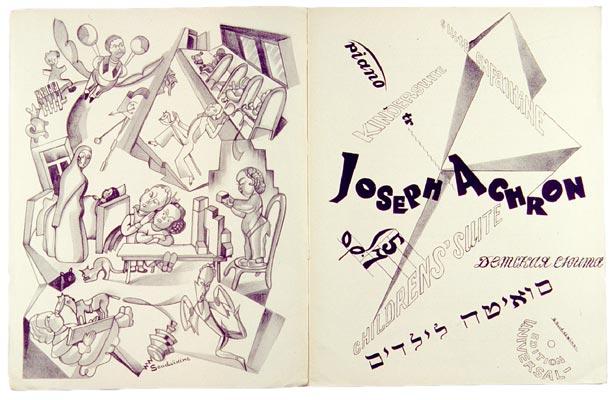
Composed in 1923.
Title also in Hebrew and Russian.
Probable first edition.
"The 'Childrens' Suite', consisting of 20 Miniatures-Primitives[,] is founded on the so called 'Trop' (old Synagogue Chant, sung during the reading of the Thora [Bible]), used quite freely"--p. [2]
"Title and illustrations after original drawings by Serge Soudeïkine"-- p. 2
Duration: 23:07.
Soudeikine, Serge, illustrator.
Adolf Hohenstein
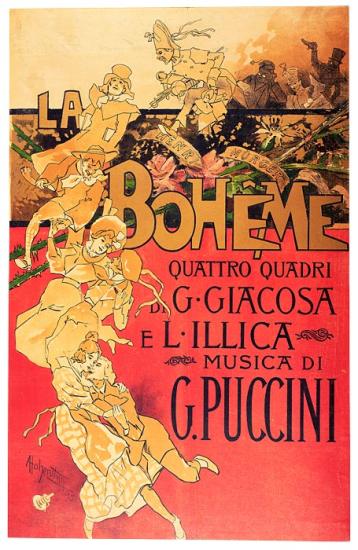
Poster for the original production of La Bohème
Milan: Officine Grafiche Ricordi, 1895
James Fuld Collection
In 1874 the firm of Ricordi established an in-house printing operation to promote its music. Adolf Hohenstein, a set designer at La Scala, joined Ricordi in 1889. As its art director, he produced covers for librettos, music scores, posters, playbills, and postcards. A master of the Art Nouveau style, Hohenstein is often referred to as the "father of the Italian poster." Under his direction, a host of graphic designers emerged.
Autograph letter signed, dated : Torre del Lago, 6 July 1911, to Carla Toscanini in Rome, 1911 July 6.

Toscanini, Carla, recipient.
Calm sea and prosperous voyage : autograph manuscript, 1833-1834.

"Meeresstille und glückliche Fahrt eine Ouvertüre für ganzes Orchester."
Full score.
Breitkopf & Härtel Archiv, no. 65.
Cary, Mary Flagler, former owner.
Cherubino's aria from The marriage of Figaro : autograph manuscript, 1786?

"Atto Imo Aria di Cherubino. Scena V."
The aria from Mozart's opera in his own arrangement for voice, violin, and piano.
Libretto by Lorenzo Da Ponte.
Published in Wolfgang Amadeus Mozart, Neue Ausgabe sämtlicher Werke, Ser. II, Werk. 5, Bd. 16, vol. 2, p. 618-624.
Julius André.
Da Ponte, Lorenzo, 1749-1838, librettist.
André, Julius, 1808-1880, former owner.
Der Herr ist mein getreuer Hirt, BWV 112 : autograph manuscript, 1731 Apr. 8.

"J. Der Herr ist mein getreüer Hirt p. à 4 Voci. 2 Corni: 2 Hautb: d'Amour 2 Violini Viola e Cont. di J S Bach."
Full score.
Libretto by W. Meuslin.
Watermark: Hunting horn and countermark, letters "GV".
Wilhelm Friedemann Bach; Karl Pistor; Marie Hoffmeister, née Lichtenstein; Ernst Rudorff; Max Abraham?; Henri Hinrichsen; Walter Hinrichsen.
Musculus, Wolfgang, 1497-1563, librettist.
Bach, Wilhelm Friedemann, 1710-1784, former owner.
Pistor, Karl, former owner.
Hoffmeister, Marie, former owner.
Abraham, Max, 1831-1900, former owner.
Hinrichsen, Henri, 1868-1942, former owner.
Hinrichsen, Walter, 1907-1969, former owner.
Cary, Mary Flagler, former owner.
Earliest compositions, K. 1a-1d : manuscript in the hand of Leopold Mozart, 1761.
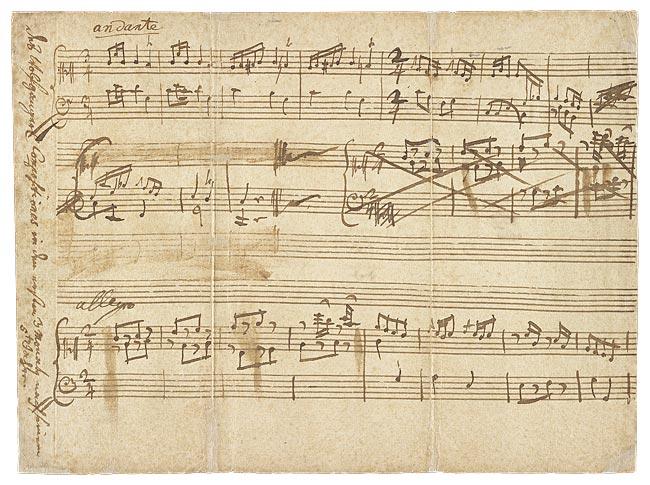
In the margin of fol. 1v: "Des Wolfgangerl Compositiones in den ersten 3 Monat[en] nach seinem / 5ten Jahre." Between the staves at the beginning of K. 1c: "Sgr: Wolfgango Mozart. 11ten Decembris 1761." At the top of K. 1d: "Menuetto del Sgr: Wolfgango Mozart 16:ten Decembris [1]761."
Andante, C major -- Allegro, C major -- Allegro, F major -- Menuetto, F major.
For keyboard.
Ms. in the hand of Leopold Mozart.
Folios 4 and 5 from Nannerl Mozart's Music Book ("Nannerl's Notenbuch"). K. 1a and the beginning of K. 1b are on fol. 1v; the rest of K. 1b, and K. 1c, are on fol. 2r; K. 1d is on f. 2v; fol. 1r has diagrams of musical intervals, with their Latin and German descriptions.
H. J. Laufer (London).
Mozart, Leopold, 1719-1787, transcriber.
Laufer, Henry John, d. 1956, former owner.
Mozart, Wolfgang Amadeus, 1756-1791. Andantes, piano, K. 1a, C major.
Mozart, Wolfgang Amadeus, 1756-1791. Allegros, piano, K. 1b, C major.
Mozart, Wolfgang Amadeus, 1756-1791. Allegros, piano, K. 1c, F major.
Mozart, Wolfgang Amadeus, 1756-1791. Minuets, piano, K. 1d, F major.
Edipo a Colono : autograph manuscript, 1817?
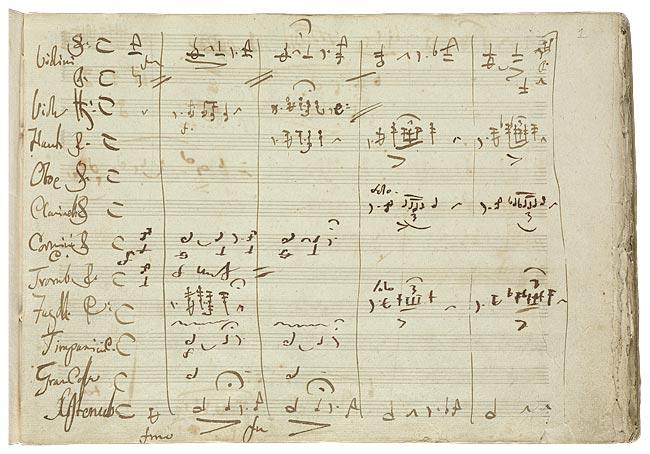
On the cover: "Cori dell'edipo a Colono posti in musica dal Mro Rossini a. 1817." On a preliminary leaf is a note, in another hand, signed by Rossini: "Je soussigné, G. Rossini, compositeur de musique, autorise Mons. Masset, à graver dans la forme qu'il voudra, mon manuscrit d'Œdipe à Colonne, qu'il a acheté de Mons. Gabussi, et je m'engage à reconnaître les cessions qu'il pourrait en faire à l'étranger. Paris le 28 Juillet 1843. Gioachino Rossini." Below that is another note: "Offert à Mons. Brandus, mon successeur. Souvenir d'amitié et de très bonnes relations, par E. Masset."
Incidental music for the play by Giuseppe Giusti, after Sophocles.
Full score.
Ms., partly autograph; cover text in another hand.
Gabussi; E. Masset; Brandus.
Giusti, Giuseppe, 1809-1850.
Gabussi, former owner.
Masset, E., former owner.
Brandus, former owner.
Etude for piano, op. 10, no. 7, in C major : autograph manuscript, 1832.
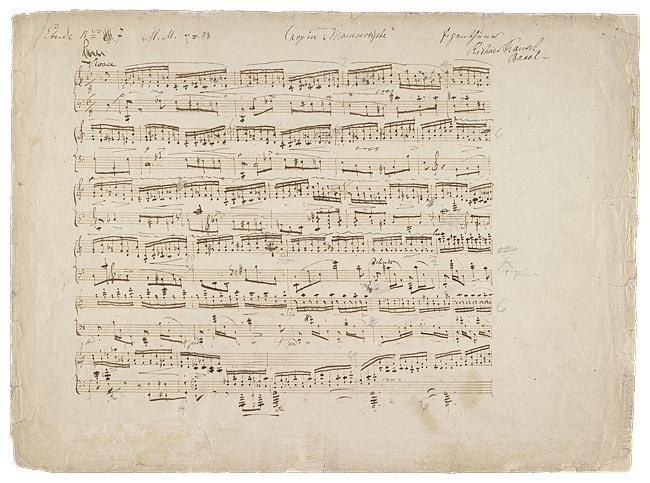
"Etude Nro 7." At the end: "Ch."
Eduard Franck, Berlin; Richard Franck, Basel; Ernest Schelling; Mrs. Janos Scholz.
Franck, Eduard, 1817-1893, former owner.
Franck, Richard, former owner.
Schelling, Ernest, 1876-1939, former owner.
Scholz, Janos, Mrs., former owner.
Fan signed with music by Johann Strauss, Puccini and others [fan].

Slat 1. Henri Meilhac -- Slat 2. ? -- Slat 3. ? Karlsbad July 1894 -- Slat 4. Felix Weingartner, Carlsbad July 26, 1892 -- Slat 5. Millöcker with music and words Feb. 18, 1890 -- Slat 6. Victor ? March 31, 1895; Siegfried Wagner, Bayreuth -- Slat 7. Alfred Grunfeld, Karlsbad, July 28, 1902; Friedrich ?, Karlsbad, July 11, 1895; Theodor Leschetizky, July 29, 1902 -- Slat 8. Giacomo Puccini with the music of Mimì's "Mi chiamano Mimì" from "La Bohème," 1912; Johann Strauss with the first 6 bars of music from "Kaiser-Walzer" for "Fräulein Else London For Friendly Remembrance," March 17, 1892; Eduard Schütt; (on reverse) ? -- Slat 9. drawing -- Slat 10. ? with music Karlsbad 1892 -- Slat 11. Ludovic Halévy -- Slat 12. ? July 26, 1904; ? Vienna March 13, 1895
Wooden brisé fan with 12 slats (blades or sticks) signed with music by Johann Strauss, Puccini and others, Carlsbad, Bayreuth and Vienna 1890-1912
Else London; James Fuld.
Puccini, Giacomo, 1858-1924. Bohème.
Strauss, Johann, 1825-1899. Kaiser-Walzer.
Meilhac, Henri, 1831-1897.
Weingartner, Felix, 1863-1942.
Millöcker, Carl, 1842-1899.
Wagner, Siegfried, 1869-1930.
Grünfeld, Alfred.
Leschetizky, Theodor, 1830-1915.
Schütt, Eduard, 1856-1933.
Halévy, Ludovic, 1834-1908.
London, Else, former owner.
Fuld, James J., 1916-2008, former owner.
Heimweh, op. 63 no. 8 : autograph manuscript, 1874.
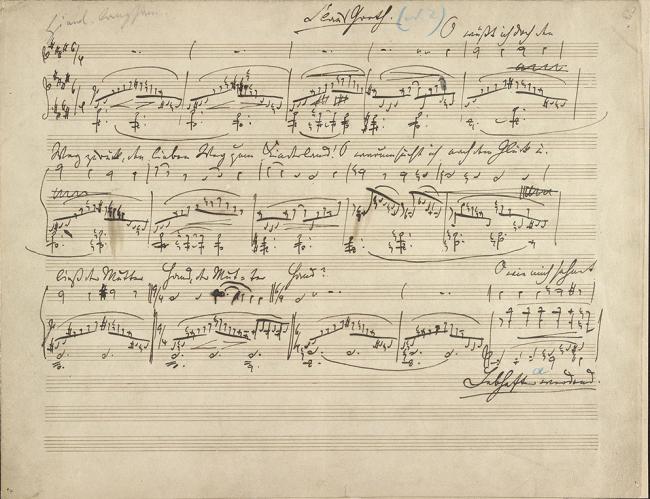
"Klaus Groth. (nr. 2)." At the end: "Johs. Brahms Rüschlikon [18]74." On the otherwise blank p. 4: "Von Brahms erhalten Wien, am Todestage Beethovens 1875. G.H."
Song; for voice and piano.
George Henschel; sold through Sotheby's (London) in 1919 to Edward Speyer; Frank Black.
Groth, Klaus, 1819-1899.
Henschel, George, Sir, 1850-1934, former owner.
Speyer, Edward, 1839-1934, former owner.
Black, Frank, former owner.
Cary, Mary Flagler, former owner.
King Arthur : autograph manuscript, 1895 Jan. 6.

"King Arthur Arthur Sullivan." At the end: "Arthur Sullivan. Jan: 6.th 1895."
Full score, for chorus and orchestra, of the incidental music for the play by J. Comyns Carr.
Wilfred Bendall.
Carr, J. Comyns (Joseph Comyns), 1849-1916.
Bendall, Wilfred, 1850-1920, former owner.
La Bohême, quattro quadri di G. Giocosa e L. Illica. musica di G. Puccini [print] / Hohenstein, 95.
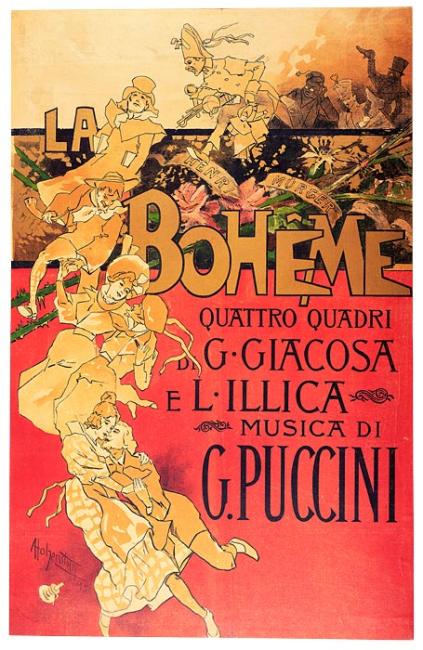
Poster for the original production of Puccini's La Bohème, 1896.
James Fuld.
Puccini, Giacomo, 1858-1924. Bohème.
Hohenstein, Adolf, 1854-1928, designer.
Giacosa, Giuseppe, 1847-1906.
Illica, Luigi, 1857-1919.
Fuld, James J., 1916-2008, former owner.
La bohème, Act 4 (sketches) : autograph manuscript, 1895 Dec. 12.

Signed, with a self-caricature: "GPuccini Torre deLago 12.12.90cinque [i.e. 12 December 1895]."
The sketch begins with Colline's "Schaunard, ognuno per diversa via mettiamo insieme due atti di pietà" and ends with the first 5 bars of his "Vecchia zimarra" in piano-vocal score.
Libretto by Illica and Giacosa.
Illica, Luigi, 1857-1919, librettist.
Giacosa, Giuseppe, 1847-1906, librettist.
La boîte à joujoux : ballet pour enfants / Claude Debussy ; argument d'André Hellé.

Possible first edition of full score.
Hellé, André, 1871-1935. Boîte à joujoux.
Master Max Darewski [print].

Postcard stamped "Birmingham / 9.15 PM / Aug 17 12B". It has a Halfpenny green stamp and addressed to "Mr. N. Humphreys / 186 Tennant St / Birmingham." In ink: "B h'am Hippodrome seen conducting local theatre orchestra".
Caption title.
Purchased on the Mary Flagler Cary Fund, 1998.
Phantasiestücke for piano, violin and violoncello, op. 88 : copyist's manuscript, 1842.
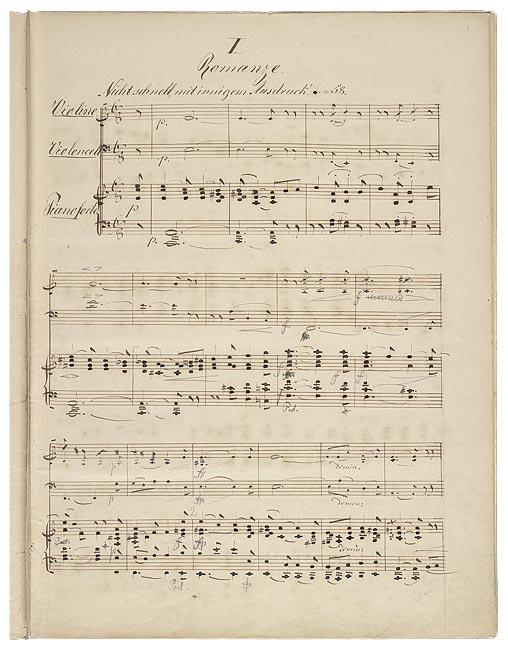
"Phantasiestücke für Pianoforte, Violine und Violoncell componirt und Frau Sophie Petersen, geb. Petit, in Altona zugeeigent von R.S."
Copyist's manuscript, with the title page, corrections, and additions in Schumann's hand.
Ernest Schelling.
Petersen, Sophie.
Schelling, Ernest, 1876-1939, former owner.
Scholz, Janos, Mrs., former owner.
Piano trio in D major, op. 70 no. 1 : autograph manuscript, 1808?

Holograph, except for the first two pages of the second movement, which are in the hand of a copyist.
Often known as the "Geister" (or "Ghost") Trio.
Watermark: Fragment, Fleur-de-lis at top. Watermark, beta radiograph, Fleur-de-lis, shield.
Watermark: Fragment, shield with diagonal stripe, below fleur-de-lis. Watermark, beta radiograph, shield with diagonal stripe.
Watermark: Countermark: Fragment, Koten Schlos. Watermark (countermark), beta radiograph.
Max Friedlaender; Franz Roehn.
Friedlaender, Max, 1852-1934, former owner.
Roehn, Franz, former owner.
Cary, Mary Flagler, former owner.
Più ridente, più lucente : autograph manuscript, between 1842 and 1845.

"Cantata." "MWBal." Marginal notation: "Madlle Nis[s]en, Madame Balfe, Mde Viardot, Madme Garcia, Mr Duprez, Mr Dupont, Mr Weiss, Mr Balfe."
For 8 solo voices, violin, violoncello and piano.
Full score.
First line of text: Più ridente, più lucente.
Author of text anonymous or unidentified.
Zimmermann, Agnes, former owner.
Sonata no. 10 in G major, op. 96, for violin and piano : autograph manuscript, 1815.
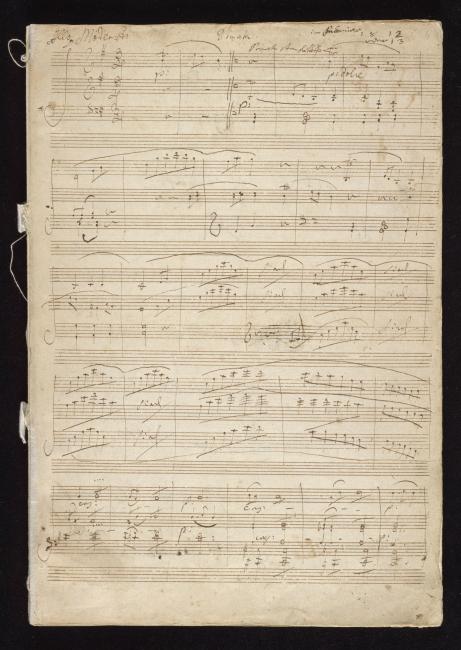
"Sonate. im Februar 1812 oder 13 Sonate von LvBeethoven."
This manuscript probably dates from early 1815 and transmits a revised version of the original 1812 version of the sonata.
Graf Lützow; Heinrich Steger(?).
Lützow, Graf, former owner.
Steger, Heinrich, former owner.
Symphony no. 1 in C minor, op. 68 : autograph manuscript, 1876 Sept.
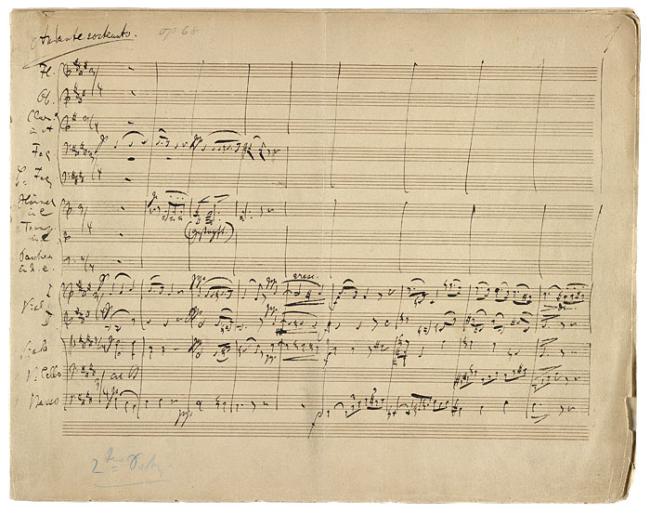
At the end: "J. Brahms Lichtenthal Sept. [18]76."
The 2nd, 3rd, and 4th movements of the Symphony no. 1; 1st movement lacking.
Full score.
N. Simrock, Berlin; Paul Gottschalk, New York; Charles Sessler, Philadelphia; Hilda Emery Davis (Mrs. Meyer Davis).
Gottschalk, Paul, 1880-1970, former owner.
Sessler, Charles, former owner.
Davis, Hilda Emery (Mrs. Meyer Davis), former owner.
Cary, Mary Flagler, former owner.
Symphony no. 35 in D major, K. 385 : autograph manuscript, 1782 July.
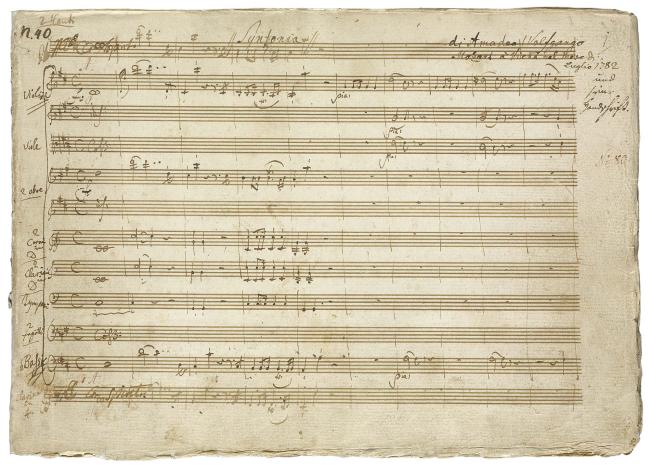
Mozart's Haffner Symphony, which was given its first public performance in Vienna on March 23, 1783 in the presence of Emperor Joseph II, originated in a commission to celebrate the ennoblement of the Salzburg patrician Sigmund Haffner (1756-1787) the previous summer. In July 1782, Mozart's father, Leopold, had written to his son in Vienna urgently requesting a new symphony for Haffner's elevation into the nobility.
In December 1782, Mozart requested the return of the manuscript from Salzburg for use in the Lenten concert he was preparing, so that he could have copies made for the performance. His father eventually complied and by mid-February 1783 the original score was back in Vienna. As Mozart wrote, "My new Haffner symphony has positively amazed me, for I had forgotten every single note of it. It must surely produce a good effect." For the public concert, he removed the opening march and one of the minuets, and increased the woodwind section.
In August 1865, this 57-page manuscript was presented as a gift by Karl Meyer Rothschild, Bavarian Consul General in Frankfurt, to King Ludwig II of Bavaria, to celebrate his twentieth birthday. It was housed in a custom built case of turquoise velvet and chased silver, which remains at the Morgan.
"Synfonia di Amadeo Wolfgango Mozart à Vien̄a nel mese di Luglio 1782."
Full score of the "Haffner" Symphony.
Johann Anton André; Julius André; Karl Mayer Rothschild; Ludwig II, king of Bavaria; Wittelsbach Trust, Munich; Max Pinette and Max Mannheim; Charles Scribner's Sons; Mary Flagler Cary; National Orchestral Association.
André, Johann Anton, 1775-1842, former owner.
André, Julius, 1808-1880, former owner.
Rothschild, Karl Mayer, former owner.
Ludwig II, King of Bavaria, 1845-1886, former owner.
Pinette, Max, former owner.
Mannheim, Max, former owner.
Cary, Mary Flagler, former owner.
Symphony no. 5 in C♯ minor : autograph manuscript, 1903 Oct.
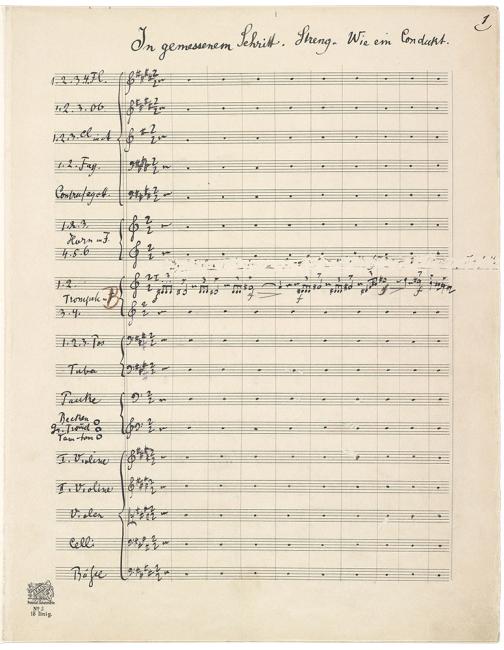
Mahler's Fifth Symphony was composed during the summers of 1901 and 1902 in his lakeside villa in the Austrian village of Maiernigg on the Worthersee and first performed in Cologne on October 18, 1904. After the first rehearsal, Mahler wrote to his wife, Alma, "The public--Oh, heavens, what are they to make of this chaos of which new worlds are forever being engendered, only to crumble in ruin the moment after? What are they to say to this primeval music, this foaming, roaring, raging sea of sound, to these dancing stars, to these breath-taking, iridescent and flashing breakers?"
This manuscript score of 297 pages is Mahler's fair copy produced during the winter of 1902-3, which he dedicated in October 1903 to "My dear Almscherl"--his affectionate term for Alma--"the faithful and brave companion on all my journeys." Mahler had married the twenty-three-year-old Alma Schindler (1879-1984) in March 1902; the Fifth Symphony's fourth movement, the tender Adagietto written for strings and harp alone, may be understood as a musical love-letter to his young bride.
"V. Symphonie für grosses Orchester von Gustav Mahler ..." At head of title: "Meinem lieben Almscherl, der trauen und tapfern Begleiterin auf allen meinen Wegen. Wien, Oktober 1903."
Full score.
Alma Mahler; Robert Owen Lehman.
Mahler, Alma, 1879-1964, dedicatee.
Mahler, Alma, 1879-1964, former owner.
Lehman, Robin, former owner.
The Star Spangled Banner; a pariotic [sic] song. Air: Anacreon in Heaven. Adapd. & arrd. by T. C.

Wolfe 8344
First edition.
Caption title.
Music ascribed to John Stafford Smith; Words by Francis Scott Key.
For piano with interlinear words; part for flute at end.
Smith, John Stafford, 1750-1836.
Carr, Thomas, 1780-1849.
Tosca : melodramma in tre atti / di V. Sardou, L. Illica, G. Giacosa ; musica di G. Puccini.

Libretto.
First ed.
Pub. no.: 103052.
Blind stamp dated December 1899: p. [1] of cover.
Illica, Luigi, 1857-1919, librettist.
Giacosa, Giuseppe, 1847-1906, librettist.
Sardou, Victorien, 1831-1908. Tosca.
Winterreise : autograph manuscript, 1827 Feb.
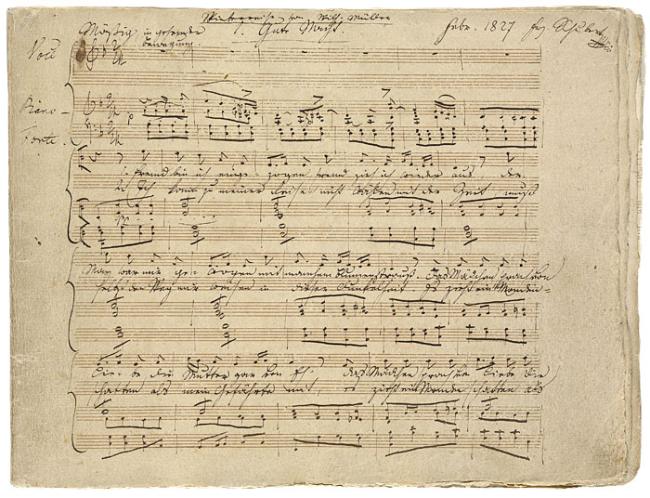
For Winterreise, Schubert returned to the poetry of Wilhelm Müller (1794-1827), whose texts were the subject of his earlier song cycle Die schöne Müllerin (1823). Suffering from syphilis and near the end of his life, Schubert set the twenty-four texts as a cycle in which a wanderer through a winter's landscape traces themes of love, loss, and emptiness.
The autograph manuscript consists of two parts: part one shows heavily emended versions, whereas part two is entirely final copy. In "Frühlingstraum" (Dream of Springtime), the singer dreams of his lost love. With the many revisions visible in the manuscript, we can witness Schubert in the process of creating the work.
P. 1: "Winterreise von Wilh. Müller Febr. 1827 Frz. Schubert mpria." At the top of p. 43: "Die Post. : Fortsetzung der Winterreise :von Wilhl Müller. Oct. 1827. Frz Schubert mpria."
Song cycle with piano.
Text by Wilhelm Müller.
Carl Haslinger; Carl Meinert; Siegfried Ochs; Louis Koch (Catalogue, no. 159).
Müller, Wilhelm, 1794-1827.
Haslinger, Carl, 1816-1868, former owner.
Meinert, Carl, former owner.
Ochs, Siegfried, former owner.
Koch, Louis, 1862-1930, former owner.
[Die Meistersinger von Nürnberg / von Richard Wagner ; vollständiger Klavierauszug von Karl Tausig].

Music drama in 3 acts; libretto by the composer.
Printed proof sheets of acts 2 and 3 of the 1st ed., with numerous corrections; those at the top of p. 177, and probably others as well, are in the composer's hand.
Title and imprint information from a copy of the published score.
1 blank leaf inserted between p. 235 and 236.
Tausig, Carl, 1841-1871, arranger.
Bülow, Hans von, 1830-1894, arranger.
[Playbill of the first Leipzig performance of Mozart's Don Giovanni by the Guardasonische Gesellschaft, June 15, 1788].
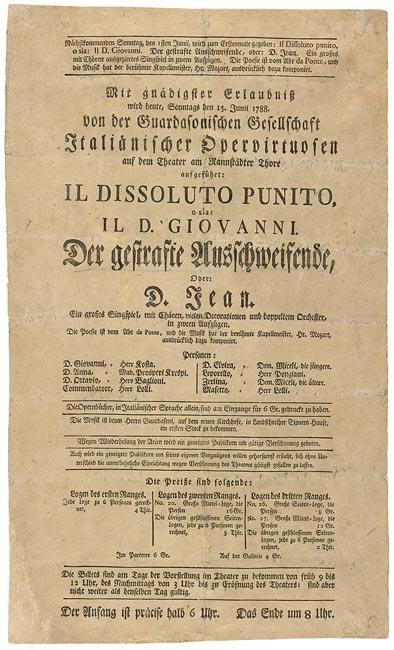
Uses many of the same performers from the first production: Donna Elvira (Micelli), Zerlina (Micelli sen.), Commendatore (Lolli), Leporello (Ponziani), Don Ottavio (Baglioni), and Masetto (Lolli). The other two roles were recast: Don Giovanni (Costa for Luigi Bassi), and Donna Anna (Crespi for Saporiti).
Mozart, Wolfgang Amadeus, 1756-1791. Don Giovanni.
Guardasoni, Domenico, 1731-1806.
Giacomo Puccini
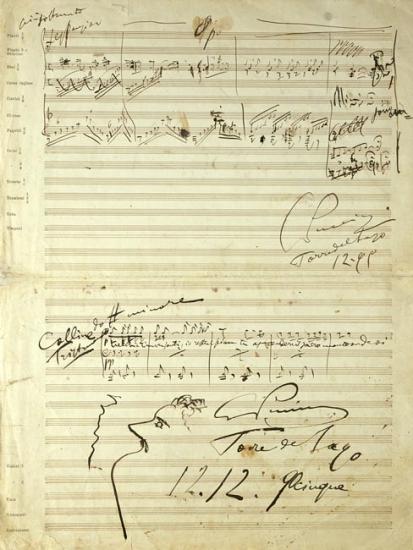
La Bohème
Sketches for Act IV
Autograph manuscript, 12 December 1895
The Dannie and Hettie Heineman Collection
This 36-measure sketch begins on the reverse side with a draft of material that precedes Mimi's Act 4 "Sono andati?" followed by Puccini's signature and date: Torre del Lago / 12.99. Further down, on the page that is displayed, are the first five measures of Colline's arioso "Vecchia zimarra" (which in the opera precedes this 36-measure sketch), followed by Puccini's self-caricature, signature, and date: Torre del Lago / 12.12.90cinque (12 December 1895). It has been suggested that the 1895 inscription dates from the completion of the work, while the signature and date of 12.99 were penned when Puccini gave the leaf away. With the success of Manon Lescaut and La Bohème, Puccini became financially secure.
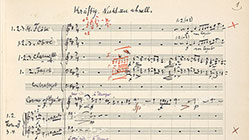
Bach used Wolfgang Meuslin's hymn of 1531 as his text, a poetic paraphrase of the 23rd Psalm. Bach composed some 300 Church Cantatas, 200 of which survive today, many of which he wrote as cantor of the school at Thomaskirche and director of church music in Leipzig from May 1723. These vocal compositions with instrumental accompaniments, in several movements, often involving a choir, were used in the liturgy of church services.
Cantata 112 has five movements, opening with a serene choral fantasia based on Nicolaus Decius's hymn "Allein Gott in der Höh sei Ehr," (Alone to God in the Highest be Glory), composed in 1523. As Bach indicates at the top of the sheet, the cantata is scored for four voices, two horns, two oboes d'amore, two violins, a viola, and continuo. It was first performed at Leipzig's Nikolaikirche on April 8, 1731, for the Misericordias Domini, celebrated on the second Sunday after Easter. It is thought that the first movement, considered one of Bach's greatest chorale fantasies, might have been copied from an earlier draft since his penmanship on these pages is so legible and assured. The composer's handwriting becomes increasingly untidy, with many more corrections, as he hurried to complete the score.